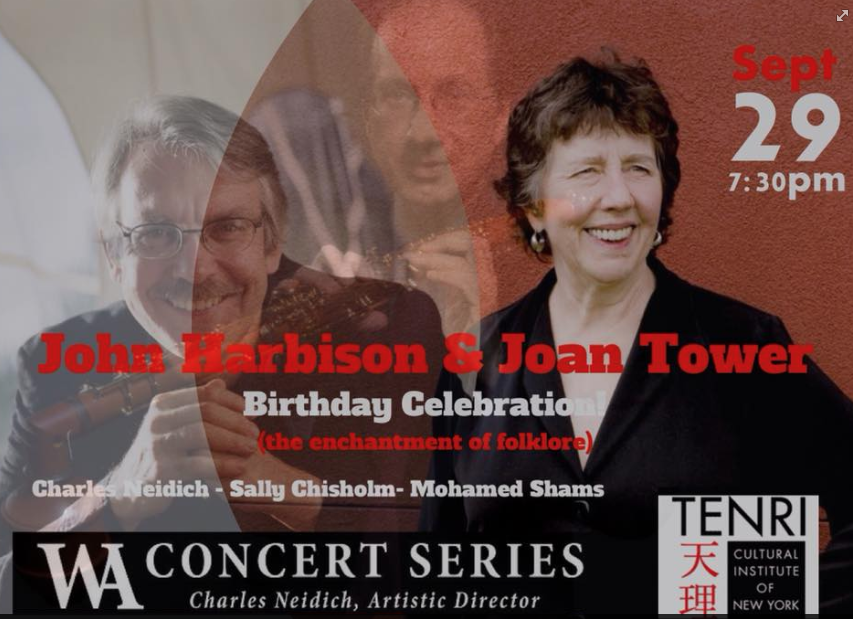Charles Neidich and Ayako Oshima, clarinet; Sally Chisholm, viola; Mohamed Shams, piano
Tenri Cultural Institute, New York, NY
September 29, 2018
The third series of “Wa” concerts opened on Saturday with customary excellence from the superb curator, clarinetist Charles Neidich and his collaborators Ayako Oshima (clarinet), Sally Chisholm (viola), and Mohamed Shams (piano). The intimacy of the Tenri space is really part of the success of these concerts, bringing chamber music back to “the chamber” as it were, surrounded by visual art as well. Besides the double birthday celebration, a sub-theme was the influence of folk music on classical “art” music, whether be from itinerant outdoor players, indigenous/religious cultures, or popular song.
On this occasion we were treated not only to the delicious symphony of food and drink prepared lovingly by his wife Ayako Oshima, but also to her deliciously elegant and appropriately humorous clarinet playing in the opening trios (six of the thirteen, Op. 47) by Franz Krommer, a Bohemian composer born three years after Mozart, whose lifespan outlasted those of Haydn, Mozart, Beethoven, and Schubert. No one is going to mistake Krommer for one of those immortals, but in the hands of such stylish virtuosi (along with energetic viola playing by Sally Chisholm), the best possible case was made for these pieces, described by Mr. Neidich as “street music” transformed and sublimated into Austro-Hungarian elegance.
Joan Tower and John Harbison both turn 80 this year. Ms. Tower was seated one chair away from me, and she does NOT seem 80, whatever that is supposed to be. She is gregarious, humorous, and of course whip-smart and talented. She introduced her fiendishly difficult clarinet solo Wings (originally titled Panthers, then Falcons, and finally Wings) by acknowledging how important the instrument has been to her for her entire career—that it “can do anything.” And boy did it do everything, in Mr. Neidich’s stunning portrayal. His ascents into the stratospheric regions of the instrument were all the more exciting preceded by the mellow low registers, every note true and melodious, somehow amid the encyclopedia of treacherous pitfalls for the player.
After this workout, no ambulance had to be summoned. Instead Mr. Neidich plunged right into Harbison’s The 9 Rasas, for clarinet, viola, and piano, a 2016 work in its New York premiere. Harbison could not be present due to work on a viola sonata for this evening’s violist, Ms. Chisholm. Harbison relates: “It interested me especially that the Rasas were conceived as juices, essences, tastes . . . In my quest to write music of diverse musical characters, and as part of a continuing wayward interest in Hindu culture, I knew even before studying the concept of the Nine Rasas that I would write a piece with that title. I approach such a piece with no intention of a touristic borrowing from the musical speech of that culture, but rather with the pleasure of seizing a musical opportunity. . . According to the Rasa theory of the Natya Shastra, entertainment is a desired effect of performance arts but not the primary goal. The primary goal is to transport the individual in the audience into another parallel reality, full of wonder and bliss, where he experiences the essence of his own consciousness, and reflects on spiritual and moral questions.” And that’s exactly what happened, with faultless unisons between clarinet and viola (always difficult to tune) and perfect ensemble with piano. And may I say, Mr. Shams is fast becoming one of my favorite collaborative chamber pianists in the New York area. His energy, sonority, and humor are seemingly infinite.
After intermission, Joan Tower’s music was again heard, this time the 1983 Fantasy (. . . those harbor lights), which contains an un-obvious programmatic reference to a difficult farewell to a romantic partner when she was sixteen, and the popular song that was playing at the time (originally written in 1937, published in 1950, and covered by such notables as Elvis Presley and The Platters). How indelible the sense of hearing can be! The work, for clarinet and piano, depicts (but not slavishly) the twinkling of lights over water, the rocking back and forth of ships, and of course the emotional intensity of the two lovers. It was a highlight of the evening for me, and the performance was preceded by just a few bars of the original song played by Mr. Shams alone. As Mr. Neidich noted, if you were counting on hearing a snippet of the song quoted literally, you were out of luck—transformation of materials at its most rigorous, yet enjoyable.
Mr. Shams then played the brief, claveciniste-inspired Minuet (for Joan Tower) by Harbison, the perfect inter-composer tribute, with clarity amid the trills and the modern tonal vocabulary, a sort of “Couperin seen through a fun-house mirror.”
The concert concluded with real Gallic “impudence” in the form of Jean Françaix’ antic Trio for clarinet, viola, and piano, brilliantly rendered by these top-of-the-line players. It roared and danced and still had time for crystalline, typically “French” sound. Bravi to all!


